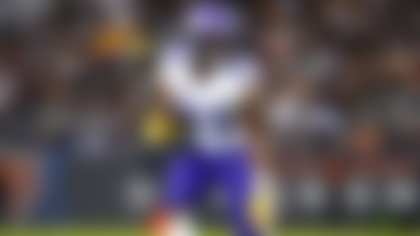MIAMI -- For all of the Joe Montana regalia in the lead-up to Super Bowl LIV, it's the tale of a less renowned quarterback which sheds more light on this clash between the high-octane offenses of the San Francisco 49ers and Kansas City Chiefs.
Alex Smith rescued each of these previously downtrodden organizations from their darkest hours, only to be traded in for a sleeker quarterback model once all of those miles out of the desert piled up in front of the first-down marker.
Having survived numerous failed regimes early in his Bay Area career, Smith led the 49ers to the 2011 NFC Championship Game before Jim Harbaugh and his staff made the bold decision to place their Super Bowl-caliber offense in the hands of young playmaker Colin Kaepernick. Salvaged from the San Francisco scrap heap in 2013, Smith was summoned to the Midwest to help Andy Reid resurrect a floundering Chiefs outfit that had fallen to 2-14 under Romeo Crennel.
FORTUNE FAVORS THE BOLD
Although Kansas City managed to amass 74 points in Smith's first two postseason appearances with the franchise -- a gutting 45-44 loss to the Colts and a 30-0 laugher over the Texans -- his conservative passing style simply left too many plays on the field in back-to-back playoff disappointments versus the Patriotsand Steelers. Once Reid and his front office assessed the strengths and weaknesses of their own Super Bowl-caliber roster in the opening months of 2017, the Chiefsoutfoxed four other Patrick Mahomes suitors to draft Smith's eventual supplanter.
Smith still had an opportunity to stave off Mahomes, finding aberrant downfield efficiency with deep threat Tyreek Hill in a career-best 2017 regular season, only to surrender a 21-3 halftime lead in heartbreaking fashion, falling to the less-talented Titans in the Wild Card Round.
Between Smith's final Kansas City victory and another early-January exit, though, his fate had already been sealed.
In a regular-season finale ironically billed as meaningless, with the next week's home-field advantage already secure, Reid unlocked the key to the NFL's next great offense with a pinch-hitting Mahomes at the helm.
"I went into that game feeling like we could score anytime," Reid disclosed to the Around The NFL Podcast at the March 2018 Annual League Meeting, two weeks after finalizing Smith's trade to the Washington Redskins. "Once I got into the game, I felt the same thing."
The Chiefs had gone 30 years without a victory from a quarterback drafted and developed in Kansas City. After snapping out of that dry spell in one fell swoop from his hand-picked franchise savior, neophyte general manager Brett Veach raised eyebrows across the football landscape by declaring that the unproven Mahomes was already one of the best players he had ever seen.
Those who had witnessed firsthand Mahomes' no-look passes and downfield air raids in practices shared Veach's unshakeable confidence, prompting immediate behavioral changes. For the first time in his 15-year career, punter Dustin Colquitt started stashing his gloves in his jersey so he'd be ready to hold for the rash of extra points that would inevitably follow Mahomes' quick-strike scores.
The most glaring change occurred in the mind of a head coach who once explained his play-calling job as getting paid to "get into a rhythm with the guy calling the defense" on the other side. The history of football's offensive strategy is a gradual gravitation away from the violent congestion in the middle of the field and toward multi-dimensional aerial attacks allowing the ball to be advanced on both the X and Y axis.
The transition from Smith to Mahomes offered an accelerated version of that evolution. Smith's penchant for throwing short passes in key situations not only tied Reid's play-calling hands, but also inspired Football Outsiders to create the ALEX (Air Less Expected) quarterback metric which measures the average difference between how far a quarterback throws a pass (air yards) and how many yards he needs for a first down. Lacking context, traditional football stats may tell us which plays the quarterback made, but they leave out the missed opportunities when the trigger isn't pulled.
While the gridiron remained the same size with Mahomes under center, Reid soon discovered that he could stress defenses by forcing them to cover the entire length and width of the field, as opposed to the condensed area boxed in by the first-down marker. By avoiding mistakes and flying over the trench warfare in the middle of the field to beat perfect coverage, the apostate Chiefs have put to rest once and for all the primitive pigskin notion that only three things can happen on a forward pass -- and two of them are bad.
To peer into the mind of a play-caller, it's instructive to examine the first 28 minutes of games, before the clock and score differential begin to dictate tendencies. While the Chiefs executed pass plays just 52 percent of the time in the first 28 minutes of Smith's starts from 2013 through '17, per The Athletic's Mike Sando, that number has surged to a league-leading 65 percent in 2019. Reid has found his rhythm in the realization that running plays are almost wasteful with the highest-rated quarterback (108.9) in NFL history orchestrating the offense.
After reaching the 30-point mark just four times in 27 postseason games across the first 58 years of the franchise's existence, the Chiefs have scored 30 or more points in all four of Mahomes' playoff starts to date.
"People thought I was crazy back at the combine, before he took a start, when I said he is the best player I've ever seen," Veach crowed after Mahomes erased a 24-0 deficit in the blink of the eye, decimating Houston's defense with a stunning array of big plays in the Chiefs' 51-31 Divisional Round victory. "He is the best player in the game. I think that's not just me saying it now, it's the whole league."
ONE OF THE GREAT PERKS OF SPORTS FANDOM
Mahomes credits Smith for providing a quarterbacking blueprint which eased the transition in Kansas City. By the time Jimmy Garoppolo arrived in San Francisco, by contrast, the 49ers were adrift, having lost the course shortly after Kaepernick blazed across the sky as a uniquely talented read-option revelation with a two-year expiration date.
Garoppolo has been the rising tide lifting all Bay Area boats, rescuing a 1-10 operation by leading the NFL in scoring during a five-game winning streak to close out the 2017 season. After suffering through the lean years of Kaepernick's collapse and Blaine Gabbert's blooper reel, 49ers fans could experience one of the great perks of sports fandom: the endless possibilities presented by a young, franchise-altering talent seemingly sent from the heavens.
After missing the majority of a lost 2018 campaign with an ACL injury, Garoppolo bounced back in impressive fashion this year, becoming the only quarterback to finish the regular season ranked in the top five in completion rate (69.1), yards per attempt (8.4) and touchdown passes (27). Belying his recency biased reputation as a well-coifed Bob Griese, Garoppolo led a well-balanced juggernaut which finished eighth in Football Outsiders' passing efficiency metric and lost just three games -- all in the closing seconds.
Smith has been dogged by the pejorative game-manager caveat throughout his tumultuous 15-year career. Should the same reputation befall an exciting young passer with Garoppolo's gaudy career average of 29.1 points per game?
While that figure is behind only his Super Bowl LIV opponent's 32.6 points per game in NFL history, no quarterback since the 1970 merger has managed a higher career winning percentage than Garoppolo's .821 (23-5). In a similar number of starts since coach Kyle Shanahan assumed control in 2017, all other 49ers quarterbacks have posted a diametrically opposed .167 (4-20) win-loss figure.
How did Griese's backups fair in comparison? When he went down with a fractured fibula and dislocated ankle in Week 5 of the Dolphins' undefeated 1972 campaign, the inimitable Earl Morrall stepped in without missing a beat, capturing Sporting News AFC Player of the Year and first-team All-Pro honors while leading the league in passer rating.
Ever since legendary Bears head coach George Halas raised the quarterback to prominence with the T-formation offense in the 1940s, the position has been measured by success on third down, in the red zone and at the end of close games. As Shanahan explained to the assembled media in Miami earlier this week, NFL teams can't run the ball if they don't have a quarterback capable of converting daunting third downs and leading fourth-quarter comebacks.
"Jimmy has been as good as anyone to me on third down this year," Shanahan testified. "When we've needed him to bring us back at the end of games, he's done it. I've never been a part of a game where a QB completes two third-and-16s on a final drive to beat the Rams like he did. What he did in that first Arizona game, I think it was a third-and-16 also, to get us back in the last drive. The second Arizona game, throwing to get back in that game."
THE NFL'S COMPETITION CURVE
Quarterback is the most scrutinized position in the American sports landscape. Famous for his portrayal of Moses in the 1956 classic The Ten Commandments, actor Charlton Heston once remarked, via Paul Zimmerman's The New Thinking Man's Guide to Pro Football, that it's easier to part the Red Sea than to play quarterback in the NFL.
The prime years of Smith's career began in 2011 with Jim Harbaugh's rebuilding San Francisco 49ers and lasted through 2017 as Reid reconstituted the Chiefs. During that time span, there weren't more than 15-20 human beings on the planet capable of playing the position at a higher level.
But what happens when an organization outgrows a capable starting quarterback, leaving him behind like Christopher Robin forsaking Winnie the Pooh?
A godsend to a team on the low end of the competition spectrum may be deadweight to a more talented club harboring realistic Super Bowl dreams. I view the phases of today's NFL competition curve as follows:
1) Expansion team
2) Organic tanking
3) Rebuilding
4) Treading water with aging nucleus
5) Loading up for playoff push
6) Division favorite
7) Super Bowl contender
8) Perennial playoff bye expectation
All too often, teams are unwilling to face grim reality, bottoming out before the failed field general is replaced. Six years after the Around The NFL Podcast established "the Dalton Scale" to illustrate football's netherworld of QB purgatory, the Bengals may finally turn the offense over to a phenom such as LSU's Joe Burrow. When the otherwise-loaded 2017 Jaguars reached the AFC Championship Game by game-planning around their quarterback's obvious limitations, they opted to double down, handing Blake Bortles a contract extension.
While the Bengals and Jaguars denied their quarterbacks' flaws in relation to their rosters' clout, the 2012 49ers and 2018 Chiefs accepted the reality that they had outgrown a limited signal-caller better suited to a Phase 4 or 5 outfit. Recognizing that an offense might learn to crawl with Smith, begin to run with Kaepernick and sprout wings with Garoppolo or Mahomes, San Francisco and Kansas City made bold decisions commensurate with their creative coaching staffs and talented cores.
Great quarterbacks don't just transform teams. They improve the lives of those around them.
As Raiders coach Jon Gruden once noted, Brett Favre was responsible for a lot of finished basements, remodeled garages, new swimming pools and wedding payments among Packers assistant coaches. Before Peyton Manning rescued the Colts from irrelevance, David Letterman quipped, Indianapolis was a small town. The local team's quarterback ended up changing the skyline of the city!
After drafting Deshaun Watson in 2017, Houston coach Bill O'Brien conceded that a true franchise quarterback's value cannot be quantified. "It's so important," O'Brien explained. "That position on any team carries the dreams, the hopes of the organization."
When O'Brien's Texans surrendered their 24-0 lead to Mahomes' blitzkrieg offense in the Divisional Round, a high-ranking Chiefs source texted TheMMQB's Albert Breer: "Incredible. The QB is from another planet."
The last time the Chiefs were in the Super Bowl, they were led by a quarterback who fired up lung darts at halftime, O.J. Simpson was the No. 1 pick in the NFL draft, Kyle Shanahan wasn't born yet and The Archies' bubble-gum pop hit "Sugar, Sugar" was Billboard's top single of the year.
Now that Andy Reid has his holy grail under center, renowned football author and lifelong Chiefs fan Michael MacCambridge believes the ghosts of playoff failures past have been "exorcised" at last in Kansas City.
"And that starts with 15," MacCambridge recently relayed to NBCSports.com's Peter King. "He's not haunted. And that's why the Chiefs are going to the Super Bowl."
You don't make history throwing short of the sticks.
Follow Chris Wesseling on Twitter @ChrisWesseling.












